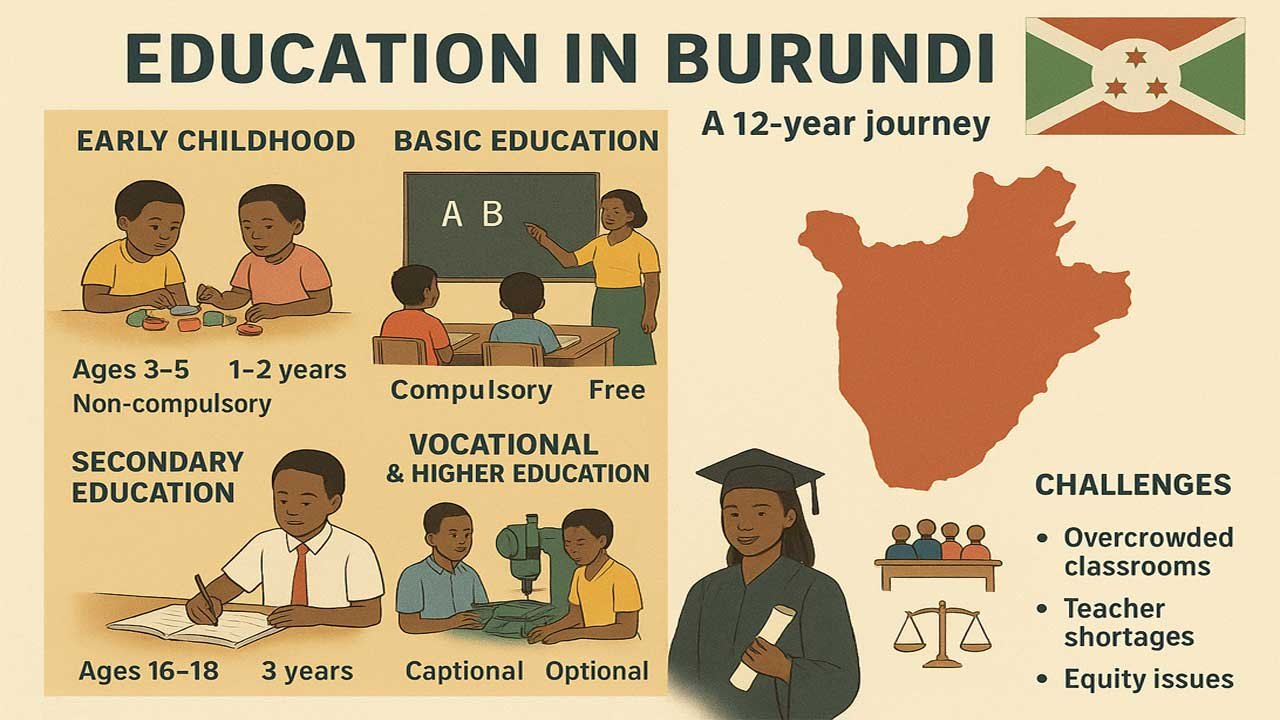Burundi’s education system, restructured through a 2010 reform into a 12-year framework centered on a nine-year basic education cycle, reflects the nation’s commitment to expanding access amid one of the world’s youngest populations.
Beginning with limited early childhood education (ages 3–5), children progress to a compulsory, free nine-year fundamental cycle (ages 6–15) that culminates in a national exam determining entry into selective post-fundamental studies or vocational training. Secondary education (Grades 10–12) offers specialized tracks leading to the State Examination, while technical and vocational programs provide practical pathways to employment.
Despite high enrollment rates, the system faces deep challenges—widespread learning poverty, high dropout rates, overcrowded classrooms, teacher shortages, and stark urban-rural inequities—all of which strain resources and undermine educational quality. Ultimately, Burundi’s progress depends on transforming its strong policy framework into equitable, high-quality learning for all children.
| Category | Key Information |
|---|---|
| Education Structure | 12-year system introduced after 2010 reform, centered on a 9-year basic education cycle. |
| Early Childhood Education | Ages 3–5; non-compulsory; low enrollment (~12% GER); mostly private/community-based. |
| Fundamental (Basic) Education | Ages 6–15; 9 years (Grades 1–9); compulsory and free; ends with Concours National de la Neuvième. |
| Language of Instruction | Kirundi in early grades; French in later grades. |
| Post-Fundamental (Secondary) Education | Ages 16–18; 3 years (Grades 10–12); specialized academic tracks; concludes with Examen d’État. |
| TVET (Technical & Vocational Education) | Starts after Grade 9; offers practical job skills; diplomas (A2, A3) lead to employment or higher study. |
| Higher Education | Begins at age 19–20; selective and low enrollment; follows Baccalauréat–Mastère–Doctorat (BMD) model. |
| Main Challenges | Low learning outcomes, high dropout rates, resource shortages, and inequity between rural and urban areas. |
| Classroom Conditions | Overcrowded (up to 75:1 pupil-classroom ratio) and under-resourced. |
| Equity Issues | Children from poor or rural families face lower access, retention, and completion rates. |
| Goal | Improve learning quality and retention while managing demographic pressure and poverty-related barriers. |
Education in Burundi: An Age-Wise Journey and the Pursuit of Quality
Education in Burundi: Age-Wise Structure, Reforms, and Quality Challenges: Education is a top priority for Burundi, a country with one of the world’s youngest and densest populations. Following major reforms, the nation transitioned to a 12-year education structure centered on a comprehensive basic cycle.
This article details the age-wise progression through Burundi’s formal education system and examines the critical challenges that temper its progress.
I. The Educational Structure: Age and Duration
Burundi’s education system is fundamentally shaped by the 2010 reform, which introduced a nine-year basic education cycle, largely consolidating the old primary and lower secondary phases.
1. Early Childhood Education (Ages 3-5)
- Duration: 1-2 years
- Status: Non-compulsory and has a very low enrollment rate (Gross Enrollment Rate is around 12%).
- Role: While acknowledged as crucial for development, capacity remains insufficient to enroll all age-eligible children, with most facilities being private or community-based.
2. Fundamental (Basic) Education: The 9-Year Cycle
- Official Entry Age: Age 6 or 7
- Duration: 9 years (Grades 1-9)
- Status: Compulsory and Free in public schools. This reform was a significant policy move aimed at retaining students and increasing the general education level.
- Curriculum: The first four years typically use Kirundi as the language of instruction, transitioning to French in later grades. The cycle ends with a national exam in Grade 9, the Concours National de la Neuvième, which is a high-stakes assessment determining eligibility and specialization placement for the next level.
3. Post-Fundamental (Secondary) Education
- Official Entry Age: Age 16 or 17 (depending on entry age and repetitions)
- Duration: 3 years (Grades 10-12)
- Specialization: This stage is highly selective and students are channeled into various specialized tracks based on their Grade 9 exam results. Common tracks include:
- Science: Math-Physics-Technology (MPT) and Biology-Chemistry-Earth Science (BCST).
- Social/Economic: Economics and Social Sciences & Humanities (SSH).
- Languages.
- The Final Exam: The cycle concludes with the state-administered Examen d’État (State Examination) in Grade 12. Passing this exam is mandatory to receive the Diplôme d’État and qualify for entry into university programs.
4. Technical and Vocational Education and Training (TVET)
- Ages: Typically pursued after the Basic cycle (Grade 9).
- Role: TVET offers practical training in fields like agriculture, mechanics, and health, providing critical skills for employment. Programs vary in length, with A2 diplomas (3-4 years) potentially allowing access to higher education, and A3 diplomas (2 years) preparing students for immediate trade work.
5. Tertiary (Higher) Education
- Official Entry Age: Age 19 or 20
- Role: Enrollment remains very low and selective. The University of Burundi is the country’s primary public institution, alongside several private universities. Programs follow the Baccalauréat–Mastère–Doctorat (BMD) structure, similar to many European systems.
II. The Quality and Equity Challenge
Despite the high Gross Enrollment Rate (often over 100% in the basic cycle, reflecting the enrollment of over-age children), the Burundian system is defined by significant internal inefficiencies and quality issues.
- Learning Poverty: The most severe challenge is the low quality of learning. Recent statistics indicate an alarmingly high rate of learning poverty, meaning a vast majority of 10-year-old children cannot read and understand a simple text.
- High Dropout Rates: While the 9-year cycle increased access, retention is poor. The completion rate for basic education hovers around 50-55%, with an even sharper decline in enrollment for adolescents (Ages 12-19) who are often pulled out of school due to household poverty, child labor, or early pregnancy.
- Resource Strain: The massive increase in enrollment, driven by the abolition of primary fees, has severely strained resources. This manifests as:
- Overcrowding: Pupil-to-classroom ratios can be as high as 75:1 in some areas.
- Teacher Shortages: High student-to-teacher ratios and limited in-service training for educators.
- Inadequate Facilities: Many schools lack basic infrastructure like clean water, sanitation facilities, and sufficient textbooks, which negatively impacts health and attendance, especially for girls.
- Geographic and Economic Inequality: Access and achievement are highly unequal. Children from the poorest quintile and those in rural areas are far more likely to be out of school and have lower completion rates than their urban and wealthier counterparts.
The success of Burundi’s age-wise education model hinges on the ability to translate high enrollment into quality learning outcomes, effectively managing the demographic pressure and addressing the persistent issues of poverty and infrastructure that force children out of the classroom.
FAQs on Burundi’s education system
What is the structure of Burundi’s education system?
Burundi’s education system follows a 12-year structure introduced by the 2010 reform, which includes a nine-year basic education cycle, a three-year post-fundamental (secondary) stage, and optional technical or higher education pathways.
At what age do children begin schooling in Burundi?
Children typically begin school at age 6 or 7, entering the first grade of the nine-year fundamental education cycle.
Is early childhood education compulsory in Burundi?
No, early childhood education for ages 3–5 is non-compulsory and has very low enrollment, mostly in private or community-based centers.
What does the fundamental (basic) education cycle include?
It covers Grades 1 to 9, is compulsory and free, and ends with a national exam called the Concours National de la Neuvième.
Which languages are used for instruction in Burundian schools?
Kirundi is used in the early grades, while French becomes the main language of instruction in later grades.
What happens after the basic education cycle?
Students who pass the Grade 9 exam progress to post-fundamental (secondary) education or enter technical and vocational training programs.
What is the focus of post-fundamental or secondary education?
It lasts three years (Grades 10–12) and allows students to specialize in science, social sciences, economics, humanities, or languages.
What is the Examen d’État?
It is the national exam taken at the end of Grade 12, required to earn the Diplôme d’État and qualify for university admission.
What opportunities exist for technical and vocational education?
Technical and Vocational Education and Training (TVET) programs provide practical skills in fields like agriculture, mechanics, and health, with A2 and A3 diplomas offering career or further study options.
When do students enter higher education in Burundi?
Students typically begin higher education at age 19 or 20 after passing the Examen d’État.
What is the structure of higher education programs?
Universities in Burundi follow the Baccalauréat–Mastère–Doctorat (BMD) structure, similar to the European system.
What are the main challenges facing Burundi’s education system?
Major issues include low learning outcomes, high dropout rates, overcrowded classrooms, limited teacher training, and inadequate facilities.
What is learning poverty, and how does it affect Burundi?
Learning poverty refers to the inability of most 10-year-olds to read and understand a simple text, highlighting severe quality gaps in education.
Why do many students drop out of school?
Common reasons include household poverty, child labor, early pregnancy, and long distances to schools, especially in rural areas.
How does poverty affect education in Burundi?
Children from the poorest families are more likely to miss school, repeat grades, or drop out early due to financial pressures and lack of support.
Are there regional disparities in education access?
Yes, rural areas face higher dropout rates, fewer qualified teachers, and poorer infrastructure compared to urban centers.
What is the pupil-to-classroom ratio in some schools?
In overcrowded regions, the ratio can reach up to 75 students per classroom, straining teaching quality and resources.
How is the government addressing education inequality?
The government has expanded free basic education, promoted gender equity, and encouraged community participation to improve access and quality.
What role do teachers play in Burundi’s education challenges?
Teacher shortages, limited training, and heavy workloads hinder effective instruction, affecting learning outcomes nationwide.
What is the completion rate for basic education?
Only about 50–55% of students complete the nine-year fundamental cycle, showing significant retention challenges.
How has the abolition of primary school fees impacted education?
It boosted enrollment but also overwhelmed school resources, leading to overcrowding and shortages in teachers and facilities.
What steps are being taken to improve learning quality?
Efforts include curriculum reforms, teacher training, and investments in infrastructure, though progress remains slow.
How do gender disparities manifest in Burundi’s education system?
Girls face higher dropout rates due to early marriage, pregnancy, and inadequate sanitation facilities in schools.
What is the ultimate goal of Burundi’s education reform?
The goal is to transform increased access into equitable, high-quality learning for all children, despite resource and demographic pressures.



Leave a Reply
You must be logged in to post a comment.